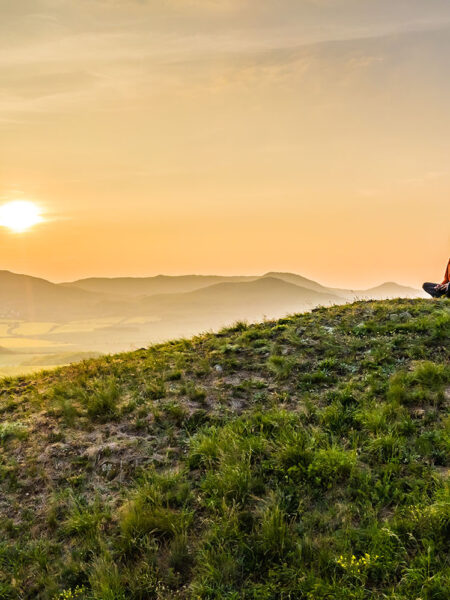If you have come across this page, you certainly know, either consciously or unconsciously, what meditation is. It is probably a matter of just starting on the path of meditation and realizing before long that it has always been and will always be a part of who you are.
And there is probably no better place to experience and learn more about meditation than Geneva (except maybe for the Himalayas themselves)! Located in a picturesque Swiss valley, with two mountain ranges, the Jura and the snow-capped Alpes adorning its surroundings, and the crescent-shaped Lake Léman (or Lake Geneva) stretching majestically to the north-east for over 70 km, Geneva offers unrivaled opportunities when it comes to experiencing meditation through nature and outdoor activities.
Here are a few examples to consider. You are skiing amidst snow-white mountains and the day is drawing to a close. You take the last cable car up the mountain slope and wait at the top until the last skier has swished by. You are now alone. You look around and breathe in, along with the fresh air, the purity and pristine beauty of the spectacular vista lying at your feet. You are between heaven and earth, almost touching the sky. The sun has just set, but its light continues to playfully outline the contours of countless ageless peaks anchored in stillness. This stillness permeates every atom around you and inside you. You too feel ageless and eternal. The silence is unbearable, almost deafening. You lie down on the ground, stretching your mildly tired body. The blue sky above you has no beginning and no end. You slowly drift into the sky on the waves of silence. You are keenly aware of your surroundings, but you are not part of them. Your sense of the body has fallen away. You have no thoughts. You simply are.
This time you are on a hiking trip on Salève. Salève is a French mountain 1,100m high just across the Swiss border. It is reachable from Geneva on a bike in less than half an hour. It is revered by bikers, hikers, paragliders and nature-lovers for its beauty, proximity and natural diversity of fauna and flora. You hike up the steep slope through small, sometimes hardly visible pathways, cutting through vegetation and gasping for more air. You walk carefully along a narrow path carved into almost a vertical wall, while holding tight to tree trunks and rocks. Your senses are on maximum alert, your heart is beating with trepidation as you move forward and up. You are making progress and after some time you are at the top.
It took some effort to get up here, but you are satisfied with the result. You behold a view of unspoken splendour. The Geneva you have grown so much used to lies before you — a small toy box glittering in the sun. You can see the grandeur of the Geneva Lake stretching to your right and disappearing into the mist between the two mountain ranges. You face the Jura mountain range across to the other side of the city. Your perception of the surroundings and your self-awareness have taken a big leap, increasing hundred-fold. You see much farther than you thought possible. As you look around, thoughts fade into the background before they disappear altogether. You take in a few deep breaths and feel a pleasant tingling in your back, a mild current going up your spine. You experience an expansion of consciousness that cannot be put into words. You are filled with joy and at peace.
These are just two examples from everyday life that bring us closer to experiencing true meditation. In true meditation, one goes beyond the boundaries of one’s body and one’s preconceived ideas and thoughts about oneself and the world. The thought process first slows down, then stops, and one experiences the stillness of being. There is nowhere to go, nothing to do, nothing to hide from, one just is. This is an advanced state, glimpses of which we have all had, but the permanence of which we have yet to establish.
Often athletes achieve a state of consciousness which is termed in the sports literature as “being in the flow”. During a peak effort and maximum concentration, the athlete suddenly loses the sense of effort and pain, while continuing to perform the task at hand with accrued strength and stamina. At that time, the athlete is acutely aware of what is happening, yet he or she appears to experience this as an observer, as someone else but themselves. It is like a switch that gets suddenly flipped inside them and they step from one room, that of everyday limited self-awareness, into another room, that of expanded consciousness and joy of effortless being. Athletes have difficulty describing this state, but words like ‘bliss’, ‘joy’, ‘expansion of self-awareness’ are often used to make reference to it.
Achieving higher states of awareness through natural means, not just haphazardly, but intentionally and methodically, is what meditation can help us with. It is a gradual process of transformation within ourselves that over time yields the fruits we seek. With sustained practice, the results become permanent. It takes regularity, self-discipline and persistence to achieve these states of ‘bliss’ not as elusory phenomena that come and go, but as a permanent state of existence. Yogis, saints and geniuses of the past have achieved these heightened levels of self-awareness and self-expansion and we can achieve them too, if only we dare apply ourselves wholeheartedly to the task before us.
“A saint is a seeker who endlessly continued.”
Sri Chinmoy
For more articles on integrating meditation into the present-day lifestyle and for more information on starting a meditation practice of your own, visit www.GenevaMeditation.ch.



